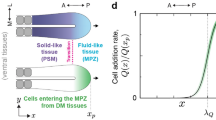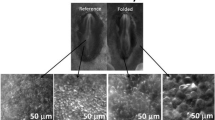Abstract
The morphogenesis of vertebrate body parts remains an open question. It is not clear whether the existence of different structures, such as a head, can be addressed by fundamental laws of tissue movement and deformation, or whether they are only a sequence of stop-and-go genetic instructions. I have filmed by time-lapse microscopy the formation of the presumptive head territory in chicken embryos. I show that the early lateral evagination of the eye cups and of the mesencephalic plate is a consequence of a sudden change in boundary conditions of the initial cell flow occurring in these embryos. Due to tissue flow, and collision of the two halves of the embryo, the tissue sheet movement is first dipolar, and next quadrupolar. In vivo air puff tonometry reveals a simple visco-elastic behaviour of the living material. The jump from a dipolar to a quadrupolar flow changes the topology of the early morphogenetic field which is observed towards a complex vortex winding with a trail (the eye cups and brain folds). The hydrodynamical model accounts for the discontinuity of the vector field at the moment of collision of the left and right halves of the embryo, at a quantitative level. This suggests a possible mechanism for the morphogenesis of the head of amniotes, as compared to cephalochordates and anamniotes.
Similar content being viewed by others
References
J. Holtfreter, J. Exp. Zoology 95, 171 (1944).
H.M. Phillips, Amer. Zool. 18, 81 (1978).
D.E. Ingberg, Int. J. Dev. Biol. 50, 255 (2006).
J.C. Gerhardt, M. Danilchik, T. Doniach, S. Roberts, B. Rowning, R. Stewart, Development 107, 37 (1989).
W. Wilson, N.J.B. Driessen, R.C.C. van Donkelaar, K. Ito, OsteoArthritis and Cartilage 14, 1196 (2006).
V. Fleury, Phys. Rev. E 61, 4156 (2000).
E. Farge, Curr. Biol. 13, 1365 (2003).
M. Unbekandt, P.M. Del Moral, F. Sala, S. Bellusci, D. Warburton, V. Fleury, Mech. Dev. 125, 314 (2008).
A.E.X. Brown, D.E. Discher, Curr. Biol. 19, R781 (2009).
M. Chuai, C. Weijer, Hum. Front. Sci. Program J 3, 71 (2009).
E.A. Zamir, B.J. Rongish, C.D. Little, PLoS Biol. 6, e247 (2008).
P. Frield, K. Wolf, J. Cell. Biol. 188, 11 (2009).
A.S. Romer, R.S. Parsons, The Vertebrate Body (Saunders College Pub., Philadelphia, 1986).
M. Callebaut, E. Van Nueten, H.Bortier, F. Harrisson, J. Morphol. 255, 315 (2003).
R. Wetzel, Vehr. physik.-med. Ges. Würzburg 40, H.5 (1924).
R. Ladher, G.C. Schoenwolf, Making a Neural Tube, Developmental Neurobiology, edited by M. Jacobson, M.S. Rao (Springer, Berlin, 2004).
K. Shariff, A.A. Leonard, Annu. Rev. Fluid. Mech. 24, 235 (1992).
V. Fleury, Organogenesis 2, 1 (2005).
V. Fleury, O.P. Boryskina, A.J.M. Cornelissen, T.-H. Nguyen, M. Unbekandt, L. Leroy, G. Baffet, F. le Noble, O. Sire, E. Lahaye, V. Burgaud, Phys. Rev. E 81, 021920 (2010).
N. Rohani, L. Canty, O. Luu, F. Fagotto, R. Winklbauer, PLoS Biol. 9, e1000597 (2011) doi:10.1371/journal.pbio.1000597
V. Fleury, Eur. Phys. J., A.P. 45, 30101 (2009).
P.A. Pouille, E. Farge, Phys. Biol. 5, 15005 (2008).
S.R. Yu, M. Burkhardt, M. Nowak, J. Ries, Z. Petrasek, S. Scholpp, P. Schwille, M. Brand, Nature 461, 533 (2009).
S.C. Morris, The Crucible of Creation: The Burgess Shale and the Rise of Animals (Oxford University Press, New York, 1998).
C. Darwin, On the origin of Species by means of natural selection or the preservation of favoured races in the struggle for life (1859).
K. Schugart, C. Kappen, F.H. Ruddle, Proc. Natl. Acad. Sci. U.S.A. 86, 7067 (1989).
F. Marlow, F. Zwartkruis, J. Malicki, S.C.F. Neuhauss, L. Abbas, M. Weaver, W. Driever, L. Solnica-Krezel, Dev. Biol. 203, 382 (1998).
Author information
Authors and Affiliations
Corresponding author
Electronic supplementary material
Rights and permissions
About this article
Cite this article
Fleury, V. A change in boundary conditions induces a discontinuity of tissue flow in chicken embryos and the formation of the cephalic fold. Eur. Phys. J. E 34, 73 (2011). https://doi.org/10.1140/epje/i2011-11073-0
Received:
Revised:
Accepted:
Published:
DOI: https://doi.org/10.1140/epje/i2011-11073-0




